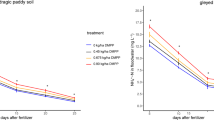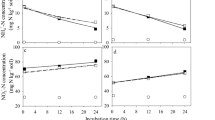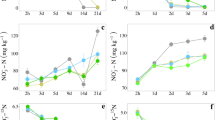Abstract
Aims
Nitrification inhibitors (NI) formulated on granulated ammonium sulphate nitrate (ASN) are an option to minimize nitrate leaching into ground waters and emissions of the greenhouse gas N2O. This paper focuses (a) on the development of an analytic enabling to extract and quantify the NI 3,4-dimethylpyrazolephosphate (DMPP), marketed since 1999. The efficiency of DMPP has been studied in laboratory and field soils. Here the DMPP analytic and the behaviour of a nitrifying bacterial consortium enriched from a field soil and exposed to zero, field applied and a 10 fold higher DMPP concentration than the recommended one for field application are in the focus.
Methods
For extracting DMPP quantitatively from soils a method connected to a HPLC analytic has been developed by us and was standardized in laboratory experiment with a silt clay field soil (allochtone Vega). The method is detailed described here. Its reliability has been tested in a 3 years field trial under varying crop** systems and climatic conditions asides the influence of DMPP on CO2−, CH4− and N2O- emissions, measured by the closed chamber method. Parallel a nitrifying bacterial consortium of the silty clay field soil was enriched and subjected to 0, the recommended DMPP concentration for field applications and a 10 times higher one. In incubation experiments the conversion of ammonium to nitrite and nitrate in presence and absence of DMPP was spectrophotometer determined and pH-shifts with a scaled litmus paper. In sacrificed flasks at the end of incubation morphological changes of the bacteria involved were studied by transmission electron microscope (TEM).
Results
The ammonium, nitrite and nitrate determinations and the TEM pictures show that in presence of the field applied DMPP concentration the nitrifying activity returned around 30 days later than in the control and the cells were slightly enlarged. In presence of a 10 times higher DMPP concentration a recovery was prevented. DMPP prolongs, compared with dicyandiamide (DCD), the period of nitrifiers’ inhibition and reduced N2O− and CO2− the emissions (Weiske et al., Biol Fertil Soils 34:109–117, 2001a, Nutr Cycl Agroecosys 60:57–64, b).
Conclusions
With the method developed by us the stability of DMPP in agricultural soils can be satisfyingly and reproducible studied down to a detection limit of 0.01 μg DMPP g−1 dry soil. The morphological changes in the nitrifying consortium due to DMPP concentrations are in agreement with the recovery rate found by nitrite and nitrate formation.






Similar content being viewed by others
References
Abasi MK, Hina M, Tahir MM (2011) Effect of Azadirachta indica (Neem), sodium thiosulphate and calcium chloride on changes in nitrogen transformation and inhibition of nitrification in soil incubated under laboratory conditions. Chempsphere 82:1629–1635
Agogué H, Brink M, Dinasquet J, Herndl GJ (2008) Major gradients in putatively nitrifying and non-nitrifying archaea in the deep North Atlantic. Nature 456:788–791
Ali R, Iqbal J, Tahir GR, Mahmood T (2008) Effect of 3,5-dimetylpyrazole and nitrapyrin on nitrification under high soil temperature Pak. J Bot 40:1053–1062
Amberger A (1986) Potentials of nitrification inhibitors in modern N-fertilizer management. Z. Pflanzenernaehr. Bodenkd 149:469–484
Andreae, M (1999) ENTEC (DMPP – ein neuer Ammoniumstabilisator: Ökotoxikologische Bewertung. In: Düngen mit einer neuen Technologie – Innovation in der Düngung. Wissenschaftliches Kolloquium Agrarzentrum der BASF Limburgerhof, 17. bis 18. Mai, 1999, 3–10
Azam F, Benckiser G, Müller C, Ottow JCG (2001) Release, movement and recovery of 3,4-dimethylpyrazole phosphate (DMPP), ammonium, and nitrate from stabilized nitrogen fertilizer granules in a silty clay soil under laboratory conditions. Biol Fertil Soils 34:118–125
Benckiser G (1994) Relationships between field-measured denitrification losses, CO2 formation and diffusional constraints. Soil Biol Biochem 26:891–899
Benckiser G (1997) Organic inputs and soil metabolism. In: Benckiser G (ed) Fauna in soil ecosystems. Marcel Dekker, New York, USA
Benckiser G (2007) Growth, denitrification and nitrate ammonification of the rhizbial strain TNAU 14 in presence and absence of C2H4 and C2H2. Ann Microbiol 57:509–514
Bollag JM, Czlonskowski ST (1973) Inhibition of methane formation in soil by various nitrogen-containing compounds. Soil Biol Biochem 5:673–678
Brochier-Armanet C, Forterre P, Gribaldo S (2011) Phylogeny and evolution of the archaea: one hundred genomes later. Curr Opin Microbiol 14:274–281
Chaves B, Opoku A, De Neve S, Boeckx P, Van Cleemput O, Hofman G (2006) Influence of DCD and DMPP on soil N dynamics after incorporation of vegetable crop residues. Biol Fertil Soils 43:62–68
Dekas AE, Poretsky RS, Orphan VJ (2009) Archaea fix and share nitrogen in methane-consuming consortia. Science 326:422–426
Di HJ, Cameron KC, Shen JP, Winefield CS, O'Callaghan M, Bowatte S, He JZ (2010) Ammonia-oxidizing bacteria and archaea grow under contrasting soil nitrogen conditions. FEMS Microbiol Ecol 72:386–394
Fuhrman JD (2011) Oceans of Crenarchaeta: a personal history describing this paradigm shift. Microbes 6:531–537
Hatch D, Trindade H, Cardenas L, Carneiro J, Hawkins J, Scholefield D, Chadwick D (2005) Laboratory study of the effects of two nitrification inhibitors on greenhouse gas emissions from a slurry-treated arable soil: impact of diurnal temperature cycle. Biol Fertil Soils 41:225–232
He J-Z, Hu H-W, Zhang L-M (2012) Current insights into the autotrophic thaumarchaeal ammonia oxidation in acidic soils Soil Biol. Biochem 55:146–154
Hutchinson GL, Mosier AR (1981) Improved soil cover methods for field measurement of nitrous oxide fluxes. Soil Sci Soc Am J 45:311–316
IPCC (1995) Climate change 1995: The science of climate change. Contribution of working group 1 to the second assessment of the intergovernmental panel on climate change. Cambridge University Press, UK
Jarell KF, Walters AD, Bochiwal C, Borgia JM, Dickinson T, Chong JPJ (2011) Major players on the microbial stage: why archaea are important. Microbiol 157:919–936
Kleineidam K, Košmrlj K, Kublik S, Palmer I, Pfab H, Ruser R, Fiedler S, Schloter M (2011) Infuence of the nitrifcation inhibitor 3,4-dimethylpyrazolephosphate (DMPP) on ammonia-oxidizing bacteria and archaea in rhizosphere and bulk soil. Chemosphere 84:182–186
Ladha JK, Reddy CK, Padre AT, van Kessel C (2011) Role of nitrogen fertilization in sustaining organic matter in cultivated soils. J Environ Qual 40:1756–1766
Lorch HJ, Benckiser G, Ottow JCG (1995) Basic methods for counting microorganisms in soil and water. In: Alef K, Nannipieri P (eds) Methods in applied soil microbiology and biochemistry. Academic, London, pp 146–161
Ma Y, Sun L, Xhang X, Yang B, Wang J, Yin B, Yan X, Xeong Z (2012) Mitigation of nitrous oxide emissions from paddy soil under conventional and no-till pratices using nitrification inhibitors during the winter wheat-growing season. Biol Fertil Soil 33:438–442
Mahmood T, Ali R, Latif Z, Ishaque W (2011) Dicyandiamide increases the fertilizer N loss from an alkaline calcareous soil treated with 15 N-labelled urea under warm climate and under different crops. Biol Fertil Soils 47:619–631
Majumder D, Datta A, Kumar S, Pathak H, Jain MC (2001) Mitigation of N2O emission from an alluvial soil by application of karan** (3 methoxyfurano 2′,3′,7,8 flavone) as nitrification inhibito in different soil types. Biol Fertil Soil 33:438–442
Majumder D, Pandiya B, Arora A & Dhara S (2004) Potential use of karan**
Martens-Habbena W, Berube PM, Urakawa H, de la Torre JR, Stahl DA (2009) Ammonia oxidation kinetics determine niche separation of nitrifying archaea and bacteria. Nature 461:976–979
Miroshnichenko IML, Gongadze GM, Rainey FA, Kostyukova AS, Lysenko M, Chernyhl NA, Bonch-Osmolovskaya EA (1998) Thermococcus gorgonarius sp. nov. And Thermococcus pacificus sp. nov.: heterotrophic extremely thermophilic archaea from New Zealand submarine hot vents. Int J Syst Bacteriol 48:23–29
Pasda G, Hähndel R, Zerulla W (2001) The effect of fertilizer with the new nitrification inhibitor DMPP (3,4-dimethylpyrazolephosphate) on yield and quality of agricultural and horticultural crops. Biol Fertil Soils 34:85–97
Poindexter JS (1978) Selection for nonbuoyant morphological mutants of Caulobacter crescentus. J Bacteriol 135:1141–1145
Politic Incentives for Climate Change Mitigation Agricultural Techniques for an agricultural policy towards the year 2020; PICCMAT, 2011. http://www.climatechangeintelligence.baastel.be/piccmat/index.php
Prosser JI, Nicol GW (2008) Relative contributions of archaea and bacteria to aerobic ammonia oxidation in the environment. Environ Microbiol 10:2931–2941
Rajbanshi SS, Benckiser G, Ottow JCG (1992) Effects on concentration, incubation temperature and repeated applications on degradation kinetics of dicyandiamide (DCD) in soils. Biol Fertil Soils 13:61–97
Ravishankara AR, Daniel JS, Portmann RW (2009) Nitrous oxide (N2O): the dominant ozone-depleting substance emitted in the 21st century. Science 326:123–125
Rinaldo S, Brunori M, Cutruzzolà F (2008) Ancient hemes for ancient catalysts. Plant Signal Behav 3:135–136
Schlichting E, Blume HP, Stahr K (1995) Bodenkundliches Praktikum. Blackwell, Berlin
Schmidt JM (1971) Prosthecate bacteria. Annu Rev Microbiol 25:93–110
Staley JT (1968) Prosthecomicrobium and Ancalomicrobium: new prosthecate fresh water bacteria. J Bacteriol 95:1921–1942
Stove JL, Stanier RY (1962) Cellular differentiation in stalked bacteria. Nature 96:1189–1192
Subbarao GV, Sahrawat KL, Nakahara K, Rao IM, Ishitani M, Hash CT, Kishii M, Bonnett DG, Berry WL, Lata JC (2012) A paradigm shift towards low-nitrifying production systems: the role of biological nitrification inhibition (BNI). Ann Bot. doi:10.1093/aob/mcs230
Sutton MA, Oenema O, Erisman JW, Leip A, van Grinsven H, Winiwarter W (2011) Too much of a good thing. Nature 472:159–161
Tindaon F, Benckiser G, Ottow JCG (2012) Evaluation of the effect of the nitrification inhibitors 3,4-dimethylpyrazole phosphate (DMPP), 4-chloro methylpyrazole (CIMP) in comparison to dicyandiamide (DCD) on non-target microbial activity in soils as assessed by dehydrogenase- and dimethylsulfoxide reductase activity. Biol Fertil Soils 48:643–650
Valentine DL (2007) Adaption to energy stress dictates the ecology and evolution of the archaea. Nature Rev Microbiol 5:316–323
VDLUFA-Methodenbuch II.I, 4. Erg. (2008) Bestimmung von 3, 4-Dimethyl-1H-pyrazol-Phosphat. 12.2.2, VDLUFA-Verlag, Darmstadt, Germany
Weiske A, Benckiser G, Herbert T, Ottow JCG (2001a) Influence of the nitrification inhibitor 3,4-dimethylpyrazole phosphate (DMPP) in comparison to dicyandiamide (DCD) on nitrous oxide emissions, carbon dioxide fluxes and methane oxidation during 3 years of repeated application in field experiments. Biol Fertil Soils 34:109–117
Weiske A, Benckiser G, Ottow JCG (2001b) Effect of the new nitrification inhibitor DMPP in comparison to DCD on nitrous oxide (N2O) emissions and methane (CH4) oxidation during 3 years of repeated applications in field experiments. Nutr Cycl Agroecosys 60:57–64
Wissemeier A, Linzmeier W, Gutser R, Weigelt W & Schmidhalter U (2002) The new nitrification inhibitor DMPP (ENTEC®) — Comparisons with DCD in model studies and field applications. Plant Nutri. Develop. Plant Soil Sci. 92, Symposium 10: 702–703, doi: 10.1007/0-306-47624-X_340
Zerulla W, Barth T, Dressel J, Erhardt K, Horchler von Locquenghien K, Pasda G, Rädle M, Wissemeier AH (2001) 3,4-Dimethylpyrazole phosphate (DMPP) – a new nitrification inhibitor for agriculture and horticulture. An Introduction Biol Fertil Soils 34:79–84
Acknowledgment
We highly regret that Prof Johannes CG Ottow, project leader when the method was developed, died unexpectedly on August 20, 2011, and we dedicate posthum this paper to him. We thank Dr. Pasda, Prof Dr. Wissemeier, BASF, PD Dr. Rod Snowdon, Department of Plant Breeding, and Prof Sylvia Schnell, Department of Applied Microbiology for helpful suggestions on the manuscript.
Author information
Authors and Affiliations
Corresponding author
Additional information
Responsible Editor: Matthias Wissuwa.
Rights and permissions
About this article
Cite this article
Benckiser, G., Christ, E., Herbert, T. et al. The nitrification inhibitor 3,4-dimethylpyrazole-phosphat (DMPP) - quantification and effects on soil metabolism. Plant Soil 371, 257–266 (2013). https://doi.org/10.1007/s11104-013-1664-6
Received:
Accepted:
Published:
Issue Date:
DOI: https://doi.org/10.1007/s11104-013-1664-6




